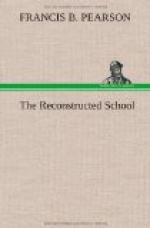Henderson well says: “We do not invariably cultivate initiative by letting children alone, but in nine cases out of ten it is a highly effective method. In our honest desire for their betterment, the temptation is always to jump in and to do for them, when we would much better keep hands off, and allow them, under favorable conditions, to do for themselves. They may do something which, from an objective point of view, is much less excellent than our own well-considered plan. But education is not an objective process. It is subjective and was wrapped up in the funny blundering little enterprise of the child, rather than in our own intrusive one.” The crude product of the boy’s work in manual training is far better for him and for the whole process of education than the finished product of the teacher’s skill which sometimes passes for the boy’s own work. Some manual training teachers have many a sin charged to their account in this line that stands in dire need of forgiveness.
There are many worthy enterprises through which initiative may be fostered. Prominent among these are some of the home and school projects that are in vogue. These projects, when wisely selected with reference to the child’s powers and inclination, give scope for the exercise of ingenuity, resourcefulness, perseverance, and unhampered thinking and acting. Besides, some of the by-products are of value, notably self-reliance and self-respect. A child yearns to play a thinking part in the drama of life and not the part of a marionette or jumping-jack that moves only when someone pulls the string. He yearns to be an entity and not a mere echo. Paternalism, in our school work, does not make for self-reliance, and, therefore, is to be deplored. There is small hope for the child without initiative, who is helped over every slightest obstacle, and who acquires the habit of calling for help whenever he encounters a difficulty.
Here we have ample scope for the problem element in teaching and we are recreant to our opportunities and do violence to child-nature if we fail to utilize this method. We are much given to the analytic in our teaching, whereas the pupil enjoys the synthetic. He yearns to make things. Constructing problems in arithmetic, or history, or physics makes a special appeal to him and we do violence to his natural bent if we fail to accord him the opportunity. We can send him in quest of dramatic situations in the poem, or derivatives in his reading lesson, set him thinking of the construction of farm buildings or machinery, or lead him to seek the causes that led up to events in history. In brief, we can appeal to his curiosity and intelligence and so engage the intensest interest of the whole boy.




